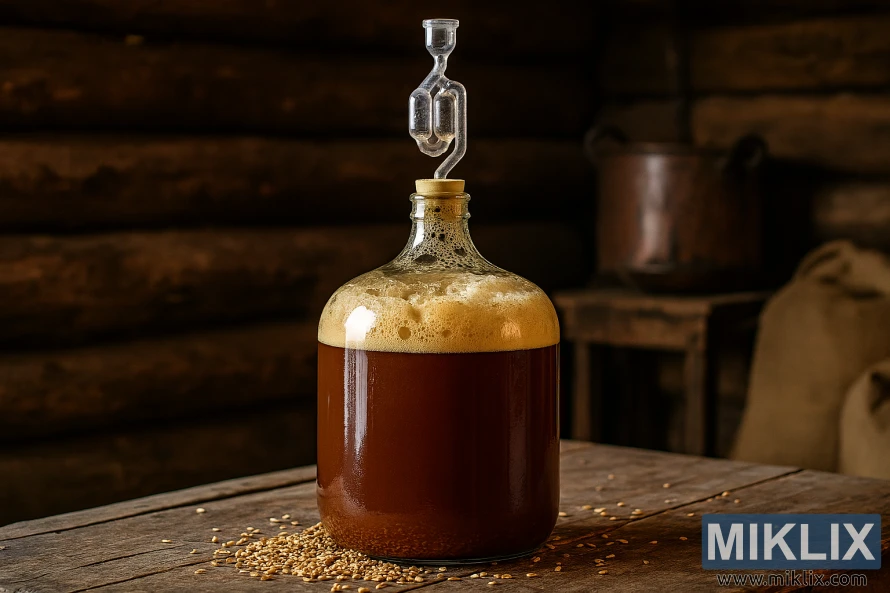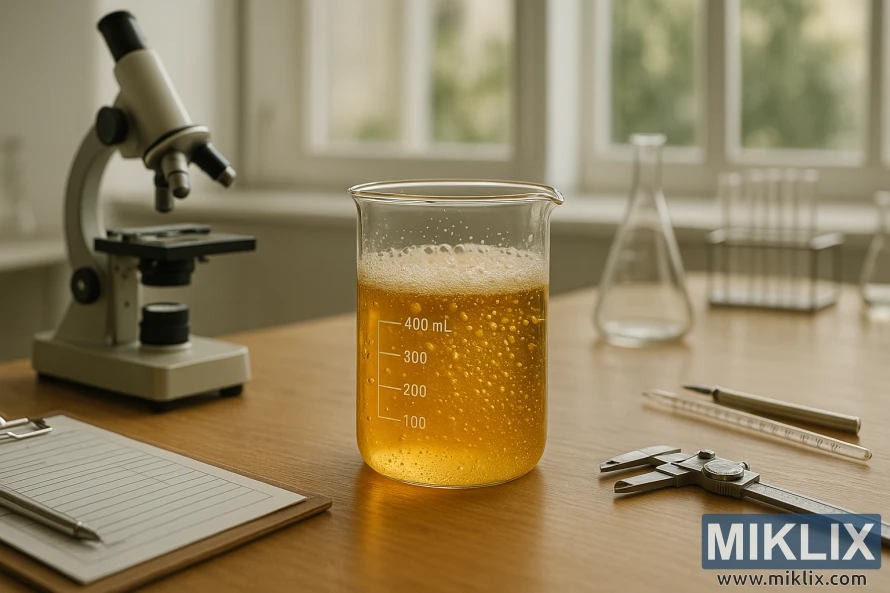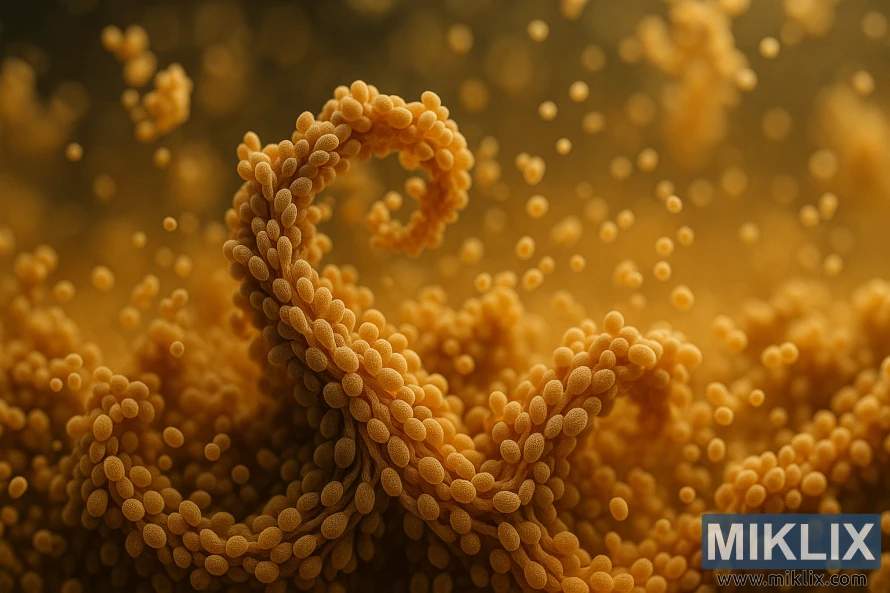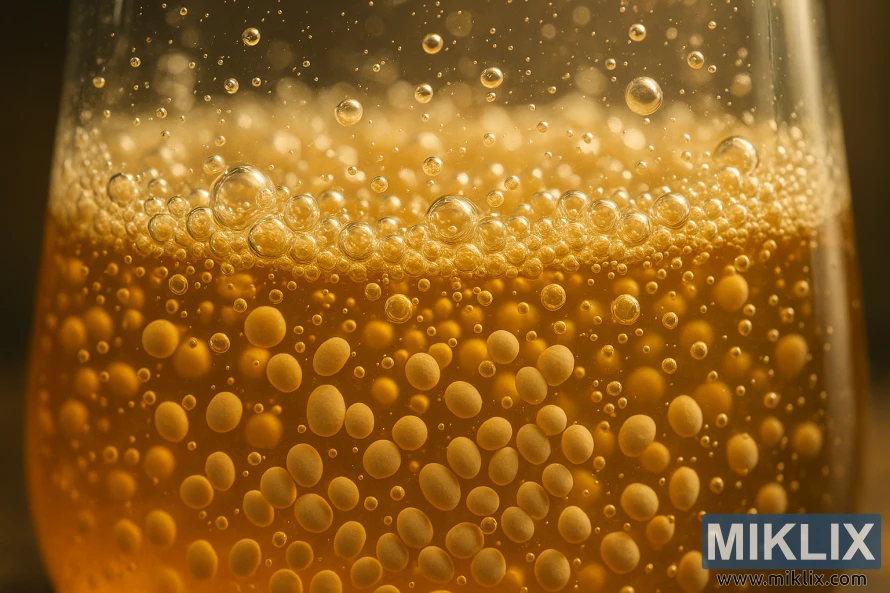Fermenting Beer with Lallemand LalBrew Abbaye Yeast
Published: July 28, 2025 at 6:39:02 AM UTC
Last updated: November 30, 2025 at 1:28:11 AM UTC
Belgian-style beers are celebrated for their rich flavors and fragrances, largely due to the yeast used in their fermentation. Lallemand LalBrew Abbaye yeast stands out as a top-fermented beer yeast. It has become a favorite among brewers for its versatility in fermenting a broad spectrum of Belgian-style beers. This includes both low and high alcohol content brews. This yeast strain excels in creating the distinctive flavors and aromas found in Belgian beers. Its consistent performance makes it a go-to choice for brewers aiming to craft authentic Belgian-style ales.

Key Takeaways
- Effective for fermenting a wide range of Belgian-style beers.
- Produces complex flavors and aromas characteristic of Belgian ales.
- Consistent performance for reliable brewing results.
- Suitable for brewing beers with low or high alcohol content.
- A popular choice among brewers for authentic Belgian-style beer.
Understanding Lallemand LalBrew Abbaye
Lallemand LalBrew Abbaye yeast is a Belgian ale yeast known for its fermentation traits. It comes from Belgium, chosen for its ability to create complex flavors and aromas. These are key to Belgian and Trappist style beers.
This yeast is versatile, suitable for a wide range of Belgian-style beers. It can handle both low and high alcohol content. It's famous for producing spicy and fruity aromas, typical of traditional Belgian brewing.
Using Lallemand LalBrew Abbaye yeast makes brewing authentic Belgian-style ales easier. Its consistent performance ensures high-quality beers that meet consumer demands.
Understanding Lallemand LalBrew Abbaye yeast helps brewers appreciate its role in creating unique beer profiles. It's a valuable tool for those exploring Belgian brewing traditions.
Technical Specifications and Requirements
The technical specifications of Lallemand LalBrew Abbaye yeast are vital for optimal brewing conditions. They determine the best environment for fermentation.
One critical aspect is the ideal fermentation temperature, which should be between 17-25°C. This range is essential for efficient fermentation. It helps in producing the desired flavors and aromas in the beer.
Brewers must also consider the yeast's requirements. Lallemand LalBrew Abbaye yeast can handle up to 14% alcohol. This makes it suitable for a wide range of beer styles.
- Optimal fermentation temperature: 17-25°C
- Alcohol tolerance: 14%
- Nutrient requirements: Adequate nutrient supply for healthy fermentation
By understanding and meeting these technical specifications and requirements, brewers can achieve a successful fermentation. This results in high-quality beer using Lallemand LalBrew Abbaye yeast.
Optimal Fermentation Conditions
To maximize the benefits of Lallemand LalBrew Abbaye yeast, brewers must carefully manage fermentation conditions. Temperature and pitching rate are key factors that impact the fermentation outcome.
The ideal temperature range for fermentation with LalBrew Abbaye yeast is 17-25°C. Keeping the temperature within this range supports a healthy fermentation process. It also aids in achieving the desired flavor profile.
Alongside temperature, the pitching rate is also critical. A recommended pitching rate of 1-2 million cells/mL/°P is advised for LalBrew Abbaye yeast. This rate ensures the yeast is stressed enough to produce the desired fermentation characteristics.
Key considerations for optimal fermentation conditions include:
- Temperature range: 17-25°C
- Pitching rate: 1-2 million cells/mL/°P
- Monitoring fermentation temperature to prevent deviations
- Ensuring proper yeast rehydration and pitching techniques
By controlling these factors, brewers can optimize the fermentation process. This results in high-quality beer with LalBrew Abbaye yeast.

Flavor Profile Analysis
LalBrew Abbaye yeast offers a unique flavor profile, featuring tropical fruit, spice, and banana notes at warmer fermentation temperatures. It's renowned for its ability to produce the spicy and fruity aromas found in Belgian and Trappist beers.
Lallemand LalBrew Abbaye yeast is perfect for brewing a variety of Belgian-style beers. Its complex flavor profile includes:
- Fruity aromas with notes of tropical fruit
- Spicy flavors typical of Belgian beers
- Flavors of banana, more pronounced at higher fermentation temperatures
These elements significantly enhance the beer's aroma and flavor, making LalBrew Abbaye a favorite among brewers. They seek to craft authentic Belgian-style ales.
Attenuation and Alcohol Tolerance
Understanding the attenuation and alcohol tolerance of Lallemand LalBrew Abbaye is key to achieving optimal fermentation. LalBrew Abbaye yeast has an attenuation range of 77-83%. This shows its ability to effectively ferment a wide range of sugars.
This yeast strain also demonstrates a high alcohol tolerance of up to 14%. This makes it suitable for brewing strong Belgian-style ales. The combination of high attenuation and alcohol tolerance allows brewers to produce complex, full-bodied beers with a rich flavor profile.
The LalBrew Abbaye yeast's performance characteristics make it an ideal choice for brewers. They seek to create traditional Belgian-style beers with consistent quality and flavor.
Flocculation Characteristics
The flocculation traits of Lallemand LalBrew Abbaye yeast are key to its sedimentation rate and beer clarity. Flocculation is the process where yeast cells clump and settle, leading to clearer beer. This is vital for brewers aiming for a refined final product.
LalBrew Abbaye exhibits a flocculation of Medium-High, with a sedimentation rate of 70-80%. This means the yeast clumps and settles quickly. This characteristic aids in achieving a clearer beer, making it ideal for various Belgian-style brews.
Understanding the flocculation of Lallemand LalBrew Abbaye yeast is essential. It's perfect for brewing a wide range of Belgian-style beers. Clarity and sedimentation are critical in these styles, and this yeast delivers.
- Medium-High flocculation rating
- Sedimentation rate of 70-80%
- Suitable for brewing Belgian-style beers
By grasping the flocculation characteristics of Lallemand LalBrew Abbaye yeast, brewers can refine their brewing techniques. This ensures the quality of their beer meets their standards.

Brewing Performance Assessment
Lallemand LalBrew Abbaye yeast is celebrated for its outstanding brewing performance. It boasts high fermentation efficiency, completing the process in 7-10 days on average.
This yeast is perfect for brewing a variety of Belgian-style beers. Its efficiency ensures brewers get consistent, reliable results every time.
- High fermentation efficiency
- Reliable and consistent fermentation process
- Suitable for a variety of Belgian-style beer styles
Using Lallemand LalBrew Abbaye yeast helps brewers refine their fermentation processes. This leads to the creation of high-quality beers that exceed consumer expectations.
Compatible Beer Styles
Lallemand LalBrew Abbaye yeast is perfect for brewers aiming to create authentic Belgian-style beers. It's versatile, fitting a broad spectrum of Belgian-style beers. This makes it a key tool for brewers eager to explore different recipes.
Lallemand LalBrew Abbaye yeast is ideal for brewing a variety of Belgian-style beers. This includes:
- Belgian White
- Belgian Blonde
- Belgian Golden
- Dubbel
- Tripel
- Quad
These beer styles are celebrated for their rich flavors and fragrances. Lallemand LalBrew Abbaye yeast enhances these qualities. Brewers can then achieve the distinctive taste profiles of traditional Belgian beers.
Lallemand LalBrew Abbaye yeast's compatibility with many Belgian-style beers has made it a favorite among brewers. It's suitable for brewing everything from a light Belgian Blonde to a complex Quad. This yeast ensures the fermentation process produces high-quality beers.
Aroma Development During Fermentation
Fermentation with Lallemand LalBrew Abbaye yeast leads to a rich mix of aromas. These include tropical fruit, spice, and banana notes, more pronounced at higher temperatures.
The process of aroma development during fermentation is key to a beer's final taste and smell. Lallemand LalBrew Abbaye yeast creates a broad spectrum of flavor and aroma compounds. These elements shape the beer's overall character.
Temperature during fermentation greatly affects the aroma compounds produced. For instance, warmer temperatures boost the presence of fruity and spicy aromas.
- Tropical fruit aromas are often associated with the use of Lallemand LalBrew Abbaye yeast.
- Spicy and banana notes can also be prominent, more so at higher fermentation temperatures.
- The complexity of the aroma profile makes Lallemand LalBrew Abbaye yeast suitable for a variety of beer styles.
For brewers aiming to craft beers with unique and complex flavors, understanding aroma development during fermentation is critical. It's essential for achieving distinct and complex flavor profiles.

Storage and Viability Guidelines
Proper storage of Lallemand LalBrew Abbaye yeast is essential for its viability and performance. To achieve optimal results, it is recommended to store the yeast at a consistent refrigerated temperature of 4°C.
When stored correctly, LalBrew Abbaye yeast maintains a high viability of 90% after 6 months. This ensures that the yeast remains effective and ready for use in brewing applications.
To maximize the shelf life of LalBrew Abbaye yeast, brewers should follow these storage guidelines:
- Store the yeast in a refrigerated environment at 4°C.
- Maintain a consistent storage temperature to preserve viability.
- Check the yeast's viability before use, specially after extended storage.
By adhering to these storage and viability guidelines, brewers can ensure that Lallemand LalBrew Abbaye yeast performs optimally. This results in high-quality fermented beers.
Comparison with Other Abbey Yeast Strains
Lallemand LalBrew Abbaye yeast is distinct among abbey yeast strains. Its unique traits make it a standout choice for brewing Belgian-style ales. The yeast's selection can greatly influence the beer's flavor and quality.
LalBrew Abbaye can be compared to other well-known abbey yeast strains like Wyeast 1214 and White Labs WLP500. Here are some key similarities and differences:
- Attenuation: LalBrew Abbaye has a high attenuation rate, similar to Wyeast 1214, resulting in a dry finish.
- Flocculation: It exhibits medium to high flocculation characteristics, comparable to White Labs WLP500, making it easier to clarify the beer.
- Flavor Profile: LalBrew Abbaye is known for producing complex flavors with fruity and spicy notes, similar to other abbey yeast strains.
- Alcohol Tolerance: It has a high alcohol tolerance, allowing for the brewing of stronger beers without compromising fermentation.
The comparison shows LalBrew Abbaye is a versatile yeast strain. It's suitable for brewing a wide range of Belgian-style beers. Its performance is on par with other renowned abbey yeast strains, making it a reliable choice for brewers.
In summary, LalBrew Abbaye yeast offers brewers a unique combination of characteristics. It's an ideal choice for producing high-quality Belgian-style ales. Its similarity in performance to other abbey yeast strains, coupled with its distinct advantages, positions it as a top choice among brewers.
Troubleshooting Common Issues
Troubleshooting is key for brewers using Lallemand LalBrew Abbaye yeast to get the best results. Issues like fermentation stalls and off-flavors can occur. These problems need quick solutions to avoid affecting the beer's quality.
To tackle fermentation stalls, first, check the temperature. It should be in the range recommended for LalBrew Abbaye. If it's too low, slowly raising it can help. Also, make sure the yeast is well rehydrated and the wort is well oxygenated to prevent stalls.
Off-flavors can stem from several causes, including bad yeast handling, contamination, or suboptimal fermentation conditions. Proper sanitation of equipment and correct yeast handling are essential. Keeping a close eye on temperature and specific gravity is also vital to catch issues early.
- Check and adjust fermentation temperature as needed.
- Verify proper yeast rehydration and wort oxygenation.
- Ensure equipment is sanitized to prevent contamination.
- Monitor fermentation progress closely.
By tackling these common problems, brewers can improve their use of LalBrew Abbaye yeast. This leads to high-quality beers that meet their standards.

Recipe Formulation Tips
Lallemand LalBrew Abbaye yeast is a versatile ingredient, suitable for a wide range of beer recipes. It can be used in traditional Belgian-style beers and innovative American-style ales.
When formulating a beer recipe with LalBrew Abbaye yeast, brewers must consider its unique characteristics. These characteristics will significantly impact the final flavor and aroma profile.
- Balance the yeast's ester production with the right hop variety and boil time.
- Choose malts that complement the yeast's flavor profile, such as Pilsner or Munich malts.
- Consider the brewing techniques that will enhance the yeast's characteristics, such as temperature control and fermentation rate.
Some popular beer styles that can be brewed with Lallemand LalBrew Abbaye yeast include Belgian-style tripels, dubbels, and American-style ales.
By understanding how to work with LalBrew Abbaye yeast, brewers can create complex and nuanced beer recipes. These recipes will showcase the yeast's unique properties.
Effective recipe formulation with Lallemand LalBrew Abbaye yeast requires a deep understanding. This understanding includes how the yeast interacts with different ingredients and brewing techniques.
Commercial Brewing Applications
The Lallemand LalBrew Abbaye yeast strain is perfect for large-scale commercial brewing. It offers high fermentation efficiency and consistent performance. This makes it a top choice for breweries aiming to produce high-quality Abbaye-style beers on a big scale.
Commercial breweries gain several benefits from Lallemand LalBrew Abbaye yeast:
- Reliable fermentation performance, even in large-scale brewing environments
- High attenuation levels, resulting in a dry finish and complex flavor profile
- Consistent production of esters and phenolic compounds, contributing to the beer's characteristic flavor and aroma
Lallemand LalBrew Abbaye yeast is crafted to meet commercial brewing needs. It ensures a robust and reliable fermentation process. Its consistent performance across batches is invaluable for large-scale breweries.
By using Lallemand LalBrew Abbaye yeast, commercial breweries can guarantee their Abbaye-style beers meet the highest quality standards. This satisfies the expectations of even the most discerning beer enthusiasts.
Quality Control Measures
Lallemand ensures LalBrew Abbaye yeast meets the highest standards through rigorous quality control. These checks are vital for the yeast's performance and consistency.
The quality control process involves viability testing and microbial analysis. These steps are key to confirming the yeast's quality.
Viability testing evaluates the live yeast cells' percentage. Microbial analysis, on the other hand, detects contamination by unwanted microorganisms.
- Rigorous testing protocols are in place to guarantee the quality of LalBrew Abbaye yeast.
- Quality control measures are essential for achieving consistent brewing results.
Through these quality control measures, Lallemand guarantees LalBrew Abbaye yeast's consistent performance. This allows brewers to create high-quality beers.

Homebrewer Success Stories
The LalBrew Abbaye yeast strain is highly regarded by homebrewers for its exceptional fermentation efficiency. Many have noted its consistent performance, making it a top pick for homebrewing. It's perfect for brewing Belgian-style ales or other complex beers, delivering reliable results every time.
Homebrewers have shared their positive experiences with Lallemand LalBrew Abbaye. They highlight its ability to produce high-quality beers with minimal variability. Key benefits include:
- Consistent fermentation profiles
- High attenuation rates
- Excellent flocculation characteristics
These attributes make LalBrew Abbaye a versatile yeast strain, suitable for a variety of beer styles. Homebrewers value its tolerance to different brewing conditions, allowing for flexibility in recipe formulation.
By choosing Lallemand LalBrew Abbaye, homebrewers can achieve professional-quality results. This enhances their overall brewing experience. The yeast's performance has garnered positive testimonials from brewers across the United States, further solidifying its reputation as a top choice for homebrewing.
Conclusion
Lallemand LalBrew Abbaye yeast stands out as a versatile, high-quality option for brewing a variety of Belgian-style beers. Its high fermentation efficiency and consistent performance make it perfect for brewers aiming to create authentic Belgian beers. The yeast's complex flavor profile adds depth to any brew.
In final thoughts, LalBrew Abbaye yeast gives brewers the means to craft beers that impress even the most critical palates. Whether you're brewing at home or commercially, this yeast ensures consistent, delicious results. It's a reliable choice for any brewer looking to elevate their craft.
By grasping the technical details, optimal fermentation conditions, and flavor profile of LalBrew Abbaye yeast, brewers can fully harness its capabilities. As a conclusion to this discussion, it's evident that Lallemand LalBrew Abbaye yeast is a valuable asset for any brewer's arsenal.
Further Reading
If you enjoyed this post, you may also like these suggestions:
- Fermenting Beer with CellarScience Baja Yeast
- Fermenting Beer with Fermentis SafAle US-05 Yeast
- Fermenting Beer with CellarScience Hazy Yeast
